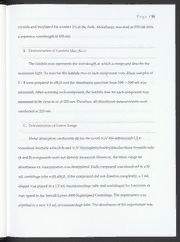
Correlation of Aqueous Solubility and Anti-Cancer Activity of Novel Triazolium and Imidazolium Salts PDF
Preview Correlation of Aqueous Solubility and Anti-Cancer Activity of Novel Triazolium and Imidazolium Salts
Columbus State UNIVERSITY CORRELATION OF AQUEOUS SOLUBILITY AND ANTI-CANCER ACTIVITY OF NOVEL TRIAZOLIUM AND IMIDAZOLIUM SALTS A THESIS SUBMITTED TO THE HONORS COLLEGE IN PARTIAL FULFILLMENT OF THE REQUIREMENTS FOR THE HONORS IN THE DEGREE OF BACHELOR OF ARTS DEPARTMENT OF CHEMISTRY COLLEGE OF LETTERS AND SCIENCES BY JARED J. BIES Page I iii ABSTRACT Novel triazolium, imidazolium, and benzimidazolium salts are known to possess anti-cancer properties and have potential as cancer therapeutics. This thesis describes the aqueous solubility and the differential activity of N,AT-bis-substituted-l,2,4- triazolium bromide salts and N/N'-bis(naphthylmethyl)imidazolium bromide salts against MDA-MB-468 breast cancer cells and PC-3 prostate carcinomas. Using a microscale technique, the partition coefficient (log P) of each salt was determined. The log P value was explored to determine the bioavailability of each derivative. Page I i v DEDICATION I would like to dedicate this thesis to my mother, father, grandmother, brother and members of the Bies Family. I would be nothing without each and every one of you. Thank you for your love and support! Page I v ACKNOWLEDGMENTS I would like to acknowledge my thesis director, Dr. Jonathan Meyers, for all his support and mentorship during this journey. Thank you for investing your time and energy to help me complete this Honors Thesis. Your guidance and knowledge has been greatly appreciated throughout this process. Also, thank you to my committee members, Dr. Kerri Taylor and Dr. Cindy Ticknor, for providing assistance to complete this research project. Thank you, Dr. Kerri Taylor, for mentorship provided to Zijie "Jerry" Lin, whom synthesized and provided the salts studied in this work. Thank you, Dr. Cindy Ticknor, for providing the support and guidance to make this Honors Thesis a reality. Thank you, Dr. Monica Frazier, for the biological assay contributions that complimented the project, which in turn allowed this research to be presented with the "complete picture." Special thanks to the number of organizations that provided funding for this project: Columbus State University (CSU) Student Research and Creative Endeavors Committee, American Chemical Society (ACS) National Chapter, ACS Auburn Local Section Chapter, CSU ACS Chapter, and CSU Honors College. A portion of the financial assistance was utilized to present this research at the 2018 ACS National Meeting in New Orleans, Louisiana. Thank you to the Department of Chemistry for providing me with the laboratory space and funding to conduct my undergraduate research. Page I vi Table of Contents ABSTRACT.iii DEDICATION. iv ACKNOWLEDGMENTS.v TABLE OF FIGURES. vii Introduction.1 I. Cancer.2 II. Triazolium and Imidazolium Salt Derivatives.2 III. Partition Coefficient and log P.6 IV. Methods and Materials..8 A. Materials.9 B. Determination of Lambda Max (Amax)..10 C. Determination of Linear Range ..10 D. Preparation and Measurement of Partition Coefficients.11 E. Calculations.12 VI. Results and Discussion. 15 A. Partition Coefficient (log P) Analysis.16 B. MDA-MB-468 Breast Cancer Cell Proliferation Assay.17 C. PC-3 Prostate Cancer Cell Proliferation Assay. 19 D. Correlation of Aqueous Solubility and Anti-Cancer Activity.21 VII. Conclusion and future work...23 VIII. References. 24 Appendix.25 I. Abbreviations. 25 Page I vii TABLE OF FIGURES Figure 1: Triazole and Imidazole Compounds. Triazoles are heterocyclic compounds containing three nitrogen atoms. The five membered rings can have four structures (Left to right: 1H-1,2,3-Triazole; 2H-1,2,3-Triazole; 1H-1,2,4-Triazole; 4H-1,2,4-Triazole). Imidazole (far right) is a heterocyclic compound with two nitrogen atoms.3 Figure 2. /V,A/'-bis-substituted 1,2,4-triazolium and imidazolium cations. 1,2,4-triazolium (left) and imidazolium (right) cations formed by di-substitution.4 Figure 3. Schematic representation of A/,/V'-bis-substituted-l,2,4-triazolium bromide salts (1- 3), A/,/V'-bis(naphthylmethyl)imidazolium bromide (4) and N,N'- bis(naphthylmethyl)benzimidazolium bromide (5) compounds.. 5 Figure 4. Partition Coefficient of Synthesized Compounds. Compound identification: Compound 1 (Dark blue), Compound 2 (Crosshatched), Compound 3 (Medium blue) Compound 4 (Diagonal lines), and Compound 5 (Light blue with dark outline). The octanol/water coefficient of compounds 1-5 was determined in a microscale assay. Positive Log P values represent an increased affinity for the octanol layer.16 Figure 5. Proliferation of MDA-MB-468 Breast Cancer Cells Treated with 1-5. Coloring is the same as Figure 4. Compounds 1 and 3 had very little anti-proliferative effects even at 30 pM. Compounds 2, 4, and 5 showed similar anti-proliferative effects at 30 pM.19 Figure 6. Proliferation of PC-3 Prostate Cancer Cells Treated with 2, 4, and 5. Coloring is the same as Figure 5. In contrast to activity against the breast cancer cell line, Compound 2 exhibited very low activity against the prostate cancer cell line. In contrast, 4 and 5 showed similar anti-proliferative effects against both cancer types.20 Page 12 I. Cancer Cancer is a devastating disease that effects over 1.5 million people each year and the annual death toll exceeds 550,000 deaths making it the second leading cause of death in the United States.12 Cancer is also one of the leading causes of death worldwide. It contributed to 8.2 million deaths in 2012.3 Due to its prevalence, an enormous amount of funding is dedicated to establishing treatments and cures. Cancer is characterized by deregulated cell proliferation. The rapidly dividing cells require several biomolecules, including fatty acids and membrane lipids, to fulfill their needs.4 Cancer has various forms and can begin in any part of the body. Left untreated, malignant cancers can metastasize. When cancer metastasis occurs, cancerous cells have the potential to compromise the integrity of other organ systems within the body and lead to death. II. Triazolium and Imidazolium Salt Derivatives Cell-specific cancer treatments exist only for a few cancers.5 Traditional chemotherapies tend to lack cell-specificity, which leads to the damage of healthy cells. Imidazole and triazole based compounds have long garnered attention for their cancer killing potential, and their salt derivatives have been shown to possess selective anticancer properties.6,7 A recent study presented a novel 1,2,3-triazolium salt that
